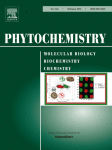Ver ítem
- xmlui.general.dspace_homeCentros e Institutos de InvestigaciónCIRN. Centro de Investigaciones de Recursos NaturalesInstituto de Recursos BiológicosArtículos científicosxmlui.ArtifactBrowser.ItemViewer.trail
- Inicio
- Centros e Institutos de Investigación
- CIRN. Centro de Investigaciones de Recursos Naturales
- Instituto de Recursos Biológicos
- Artículos científicos
- Ver ítem
Intraspecific variation in essencial oil composition of A.N. the medicinal plant Lippia integrifolia (verbenaceae), evidence for five chemotypes
Resumen
The aerial parts of Lippia integrifolia (incayuyo) are widely used in northwestern and central Argentina for their medicinal and aromatic properties. The essential oil composition of thirty-one wild populations of L. integrifolia covering most of its natural range was analyzed by GC and GC–MS. A total of one hundred and fifty two terpenoids were identified in the essential oils. Sesquiterpenoids were the dominant components in all but one of the
[ver mas...]
The aerial parts of Lippia integrifolia (incayuyo) are widely used in northwestern and central Argentina for their medicinal and aromatic properties. The essential oil composition of thirty-one wild populations of L. integrifolia covering most of its natural range was analyzed by GC and GC–MS. A total of one hundred and fifty two terpenoids were identified in the essential oils. Sesquiterpenoids were the dominant components in all but one of the collections analyzed, the only exception being a sample collected in San Juan province where monoterpenoids amounted to 51%. Five clearly defined chemotypes were observed. One possessed an exquisite and delicate sweet aroma with trans-davanone as dominant component (usually above 80%). Another with an exotic floral odour was rich in oxygenated sesquiterpenoids based on the rare lippifoliane and africanane skeletons. The trans-davanone chemotype is the first report of an essential oil containing that sesquiterpene ketone as the main constituent. The absolute configuration of trans-davanone from L. integrifolia was established as 6S, 7S, 10S, the enantiomer of trans-davanone from ‘davana oil’ (Artemisia pallens). Wild plants belonging to trans-davanone and lippifolienone chemotypes were propagated and cultivated in the same parcel of land in Santa Maria, Catamarca. The essential oil compositions of the cultivated plants were essentially identical to the original plants in the wild, indicating that the essential oil composition is largely under genetic control. Specimens collected near the Bolivian border that initially were identified as L. boliviana Rusby yielded an essential oil practically identical to the trans-davanone chemotype of L. integrifolia supporting the recent view that L. integrifolia (Gris.) Hieron. and L. boliviana Rusby are synonymous.
[Cerrar]

Autor
Juarez, Miguel Angel;
Elechosa, Miguel Angel;
Marcial, Guillermo;
Lampasona, Marina P. de;
Vega, Marta I.;
Lizarraga, Emilio;
Viturro, Carmen I.;
Slanis, Alberto;
Catalan, Cesar Atilio Nazareno;
Fuente
Phytochemistry 122 : 203-212. (February 2016)
Fecha
2016-02
ISSN
0031-9422 (Print)
1873-3700 (Online)
1873-3700 (Online)
Formato
pdf
Tipo de documento
artículo
Palabras Claves
Derechos de acceso
Restringido
 Excepto donde se diga explicitamente, este item se publica bajo la siguiente descripción: Creative Commons Attribution-NonCommercial-ShareAlike 2.5 Unported (CC BY-NC-SA 2.5)
Excepto donde se diga explicitamente, este item se publica bajo la siguiente descripción: Creative Commons Attribution-NonCommercial-ShareAlike 2.5 Unported (CC BY-NC-SA 2.5)

